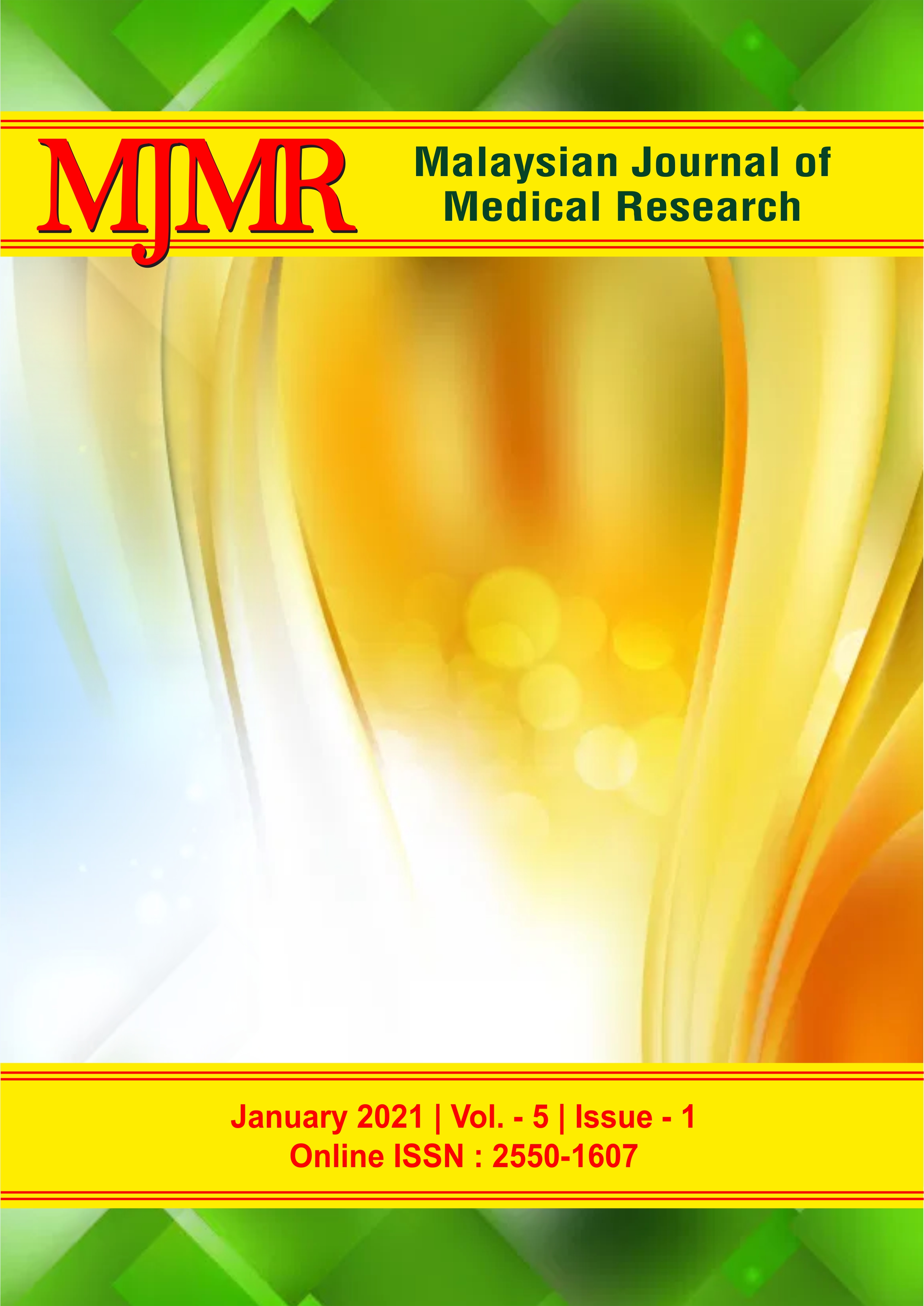POSSIBLE IMPACT OF ATMOSPHERIC PARTICULATE MATTER AND INDOOR STAYING BEHAVIOUR IN WINTER ON SARS-COV-2 TRANSMISSION: AN EXPLORATORY REVIEW
DOI:
https://doi.org/10.31674/mjmr.2021.v05i01.002Abstract
The COVID-19 pandemic caused by a zoonotic virus - Severe Acute Respiratory Syndrome Coronavirus 2 (SARS-CoV-2) demands knowledge about the impact of environmental factors in the epidemiology of the disease. Lower air temperature and lower humidity could be associated with increased SARS-CoV-2 transmission like other human coronaviruses (HCoVs). The higher stability of SARS-CoV-2 in lower temperature is also reinforcing this assumption. In winter, the levels of atmospheric particulate matter (PM) remains significantly high which could act as a mechanical transport vector for SARS-CoV-2 apart from its role as a pollutant that causes inflammation in the lungs and contribute to the severity of COVID-19. Moreover, inhaling small airborne droplets is also a probable transmission route for SARS-CoV-2 and this could be significant during longer indoor staying behavior in winter. Asymptomatic and pre-symptomatic cases of SARS-CoV-2 are also evident. High population density in urban areas forces more people to share common space inside houses, thus creating a possible virogenic environment. It is postulated that the changes in human behavior, such as staying relatively more time indoors, and the increased stability of SARS-CoV-2 during the winter months along with higher atmospheric PM concentration may develop a favorable situation for SARS-CoV-2 transmission.
Keywords:
SARS-CoV-2, Atmospheric Particulate Matter, Indoor Staying Behavior, Transmission DynamicsDownloads
References
Abdul-Rasool, S. & Fielding, B. C. (2010). Understanding Human Coronavirus HCoV-NL63. The Open Virology Journal, 4, pp:76–84.
Acharya, B. & Thapa, K. (2016). Indoor Staying During Winter Season Makes People More Susceptible to Flu. Journal of Nepal Health Research Council, 14(32), pp:69–70.
Allen, J. G. & Marr, L. C. (2020). Recognizing and controlling airborne transmission of SARS-CoV-2 in indoor environments. Indoor Air, 30(4), pp:557–558.
Bhattacharya, S., Basu, P. & Poddar, S. (2020). Changing epidemiology of SARS-CoV in the context of COVID-19 pandemic. Journal of Preventive Medicine and Hygiene, 61(2), pp:130-136.
Bhattacharya, S., Sinha S., Baidya, D. & Tilak, R. (2020) Emergence of a Zoonotic Pathogen - Novel Coronavirus (SARS-CoV-2) in the Context of Changing Environment. Journal of Communicable Diseases, 52(2), pp:67-73.
Bhattacharya, S., Sinha, S., Tilak, R. & Mardihusodo, S.J. The relationship between bats and human coronavirus: An exploratory review. Journal of Health and Social Science. 2020;5(2) pp:219-230
Biryukov, J., Boydston, J. A., Dunning, R. A., Yeager, J. J., Wood, S., Reese, A. L., Ferris, A., Miller, D., Weaver, W., Zeitouni, N. E., Phillips, A., Freeburger, D., Hooper, I., Ratnesar-Shumate, S., Yolitz, J., Krause, M., Williams, G., Dawson, D. G., Herzog, A., Dabisch, P. & ltamura, L. A. (2020). Increasing Temperature and Relative Humidity Accelerates Inactivation of SARS-CoV-2 on Surfaces. mSphere, 5(4), pp: e00441-20.
Brandt, E. B., Beck, A. F. & Mersha, T. B. (2020). Air pollution, racial disparities, and COVID-19 mortality. The Journal of Allergy and Clinical Immunology, 146(1), pp: 61–63.
Chan, K. H., Peiris, J. S., Lam, S. Y., Poon, L. L., Yuen, K. Y. & Seto, W. H. (2011). The Effects of Temperature and Relative Humidity on the Viability of the SARS Coronavirus. Advances in virology, pp: 734690.
Chatterjee, R. & Bhattacharya, S. (2020). Could Novel Corona Virus (Sars-Cov-2) Be The Evolving Face of A New Generation of Genetically Complex Epidemiological Challenge?. Malaysian Journal of Medical Research (MJMR), 4(2), pp: 42-45.
Chin, A., Chu, J., Perera, M., Hui, K., Yen, H. L., Chan, M., Peiris, M. & Poon, L. (2020). Stability of SARS-CoV-2 in different environmental conditions. The Lancet. Microbe, 1(1), pp: e10.
Comunian, S., Dongo, D., Milani, C. & Palestini, P. (2020). Air Pollution and Covid-19: The Role of Particulate Matter in the Spread and Increase of Covid-19's Morbidity and Mortality. International Journal of Environmental Research and Public Health, 17(12), pp:4487.
Conticini, E., Frediani, B. & Caro, D. (2020). Can atmospheric pollution be considered a co-factor in extremely high level of SARS-CoV-2 lethality in Northern Italy?. Environmental Pollution (Barking, Essex : 1987), 261, pp: 114465.
Cui, Y., Zhang, Z. F., Froines, J., Zhao, J., Wang, H., Yu, S. Z. & Detels, R. (2003). Air pollution and case fatality of SARS in the People's Republic of China: an ecologic study. Environmental Health : A Global Access Science Source, 2(1), pp: 15.
Devaraj, S., Tiwari, S., Ramaraju, HK., Dumka, U.C., Sateesh, M., Parmita, P. & Shivashankara, G.P.(2019) Spatial and Temporal Variation of Atmospheric Particulate Matter in Bangalore: A Technology-Intensive Region in India. Archives of Environmental Contamination and Toxicology. 77(2), pp:214-222.
Dobaradaran, S., Geravandi, S., Goudarzi, G., Idani, E., Salmanzadeh, S., Soltani, F., Yari, A.R. & Mohammadi, M.J.(2016). Determination of Cardiovascular and Respiratory Diseases Caused by PM10 Exposure in Bushehr, 2013. Journal of Mazandaran University of Medical Science, 26 (139), pp: 42-52.
Esper, F., Weibel, C., Ferguson, D., Landry, M. L. & Kahn, J. S. (2006). Coronavirus HKU1 infection in the United States. Emerging Infectious Diseases, 12(5), pp: 775–779.
Frontera, A., Martin, C., Vlachos, K. & Sgubin, G. (2020). Regional air pollution persistence links to COVID-19 infection zoning. The Journal of Infection, 81(2), pp: 318–356.
Gao, W. J. & Li, L. M. (2020). Zhonghua Liu Xing Bing Xue Za Zhi = Zhonghua Liuxingbingxue Zazhi, 41(4), pp: 485–488.
Grant, W. B., Lahore, H., McDonnell, S. L., Baggerly, C. A., French, C. B., Aliano, J. L. & Bhattoa, H. P. (2020). Evidence that Vitamin D Supplementation Could Reduce Risk of Influenza and COVID-19 Infections and Deaths. Nutrients, 12(4), pp: 988.
Jandacka, D. & Durcanska, D. (2019) Differentiation of Particulate Matter Sources Based on the Chemical Composition of PM10 in Functional Urban Areas. Atmosphere, 10, pp: 583.
Hughes, D. A. & Norton, R. (2009). Vitamin D and respiratory health. Clinical and Experimental Immunology, 158(1), pp: 20–25.
Kohanski, M. A., Lo, L. J. & Waring, M. S. (2020). Review of indoor aerosol generation, transport, and control in the context of COVID-19. International Forum of Allergy & Rhinology, 10(10), pp: 1173–1179.
Konala, V. M., Adapa, S., Gayam, V., Naramala, S., Daggubati, S. R., Kammari, C. B. & Chenna, A. (2020). Co-infection with Influenza A and COVID-19. European Journal of Case Reports In Internal Medicine, 7(5), pp: 001656.
Li, Y., Wang, X. & Nair, H. (2020). Global Seasonality of Human Seasonal Coronaviruses: A Clue for Postpandemic Circulating Season of Severe Acute Respiratory Syndrome Coronavirus 2?. The Journal of Infectious Diseases, 222(7), pp: 1090–1097.
Liang, Y., Fang, L., Pan, H., Zhang, K., Kan, H., Brook, J. & Sun, O. (2014) PM2.5 in Beijing - temporal pattern and its association with influenza. Environmental Health, 13, pp: 102.
Lin, C. I., Tsai, C. H., Sun, Y. L., Hsieh, W. Y., Lin, Y. C., Chen, C. Y. & Lin, C. S. (2018). Instillation of particulate matter 2.5 induced acute lung injury and attenuated the injury recovery in ACE2 knockout mice. International journal of biological sciences, 14(3), pp: 253–265.
Marik, P. E., Kory, P. & Varon, J. (2020). Does vitamin D status impact mortality from SARS-CoV-2 infection?. Medicine in drug discovery, 6, pp: 100041.
Martelletti, L. & Martelletti, P. (2020). Air Pollution and the Novel Covid-19 Disease: a Putative Disease Risk Factor. SN comprehensive clinical medicine, 1–5. Advance online publication. https://doi.org/10.1007/s42399-020-00274-4
Marzouni, M. B., Moradi, M., Zarasvandi, A., Akbaripoor, S., Hassanvand, M. S., Neisi, A., Goudarzi, G., Mohammadi, M. J., Sheikhi, R., Kermani, M., Shirmardi, M., Naimabadi, A., Gholami, M., Mozhdehi, S. P., Esmaeili, M. & Barari, K. (2017). Health benefits of PM10 reduction in Iran. International Journal of Biometeorology, 61(8), pp: 1389–1401.
Morawska, L., Tang, J. W., Bahnfleth, W., Bluyssen, P. M., Boerstra, A., Buonanno, G., Cao, J., Dancer, S., Floto, A., Franchimon, F., Haworth, C., Hogeling, J., Isaxon, C., Jimenez, J. L., Kurnitski, J., Li, Y., Loomans, M., Marks, G., Marr, L. C., Mazzarella, L. & Yao, M. (2020). How can airborne transmission of COVID-19 indoors be minimised?. Environment International, 142, pp:105832.
Murtas, R. & Russo, AG. (2019) Effects of pollution, low temperature and influenza syndrome on the excess mortality risk in winter 2016-2017. BMC Public Health, 19(1), pp:1445.
Neher, R. A., Dyrdak, R., Druelle, V., Hodcroft, E. B. & Albert, J. (2020). Potential impact of seasonal forcing on a SARS-CoV-2 pandemic. Swiss Medical Weekly, 150, pp: w20224.
Radujkovic, A., Hippchen, T., Tiwari-Heckler, S., Dreher, S., Boxberger, M. & Merle, U. (2020). Vitamin D Deficiency and Outcome of COVID-19 Patients. Nutrients, 12(9), pp: 2757.
Ratnesar-Shumate, S., Williams, G., Green, B., Krause, M., Holland, B., Wood, S., Bohannon, J., Boydston, J., Freeburger, D., Hooper, I., Beck, K., Yeager, J., Altamura, L. A., Biryukov, J., Yolitz, J., Schuit, M., Wahl, V., Hevey, M. & Dabisch, P. (2020). Simulated Sunlight Rapidly Inactivates SARS-CoV-2 on Surfaces. Journal of Infectious Diseases, 222(2).
Setti, L., Passarini, F., De Gennaro, G., Barbieri, P., Perrone, M. G., Borelli, M., Palmisani, J., Di Gilio, A., Torboli, V., Fontana, F., Clemente, L., Pallavicini, A., Ruscio, M., Piscitelli, P. & Miani, A. (2020). SARS-Cov-2RNA found on particulate matter of Bergamo in Northern Italy: First evidence. Environmental Research, 188, pp:109754.
Shen, Y., Li, C., Dong, H., Wang, Z., Martinez, L., Sun, Z., Handel, A., Chen, Z., Chen, E., Ebell, M. H., Wang, F., Yi, B., Wang, H., Wang, X., Wang, A., Chen, B., Qi, Y., Liang, L., Li, Y., Ling, F.& Xu, G. (2020). Community Outbreak Investigation of SARS-CoV-2 Transmission Among Bus Riders in Eastern China. JAMA Internal Medicine, e205225. Advance online publication.
Sooryanarain, H. & Elankumaran, S. (2015). Environmental role in influenza virus outbreaks. Annual Review of Animal Biosciences, 3, pp: 347–373.
Thieden, E., Philipsen, P. A. & Wulf, H. C. (2006). Ultraviolet radiation exposure pattern in winter compared with summer based on time-stamped personal dosimeter readings. The British Journal of Dermatology, 154(1), pp: 133–138.
V, A., R, V. & Haghighat, F. (2020). The contribution of dry indoor built environment on the spread of Coronavirus: Data from various Indian states. Sustainable Cities and Society, 62, pp: 102371.
Vinitketkumnuen, U., Kalayanamitra, K., Chewonarin, T. & Kamens, R. (2002). Particulate matter, PM 10 & PM 2.5 levels, and airborne mutagenicity in Chiang Mai, Thailand. Mutation Research, 519(1-2), pp: 121–131.
WHO (2013). Health effects of particulate matter. Policy implications for countries in eastern Europe, Caucasus and central Asia. Copenhagen: WHO Regional Office for Europe; 2013 Retrieved From: http://www.euro.who.int/__data/assets/pdf_file/0006/189051/ Health-effects-of-particulate-matter-final-Eng.pdf
WHO (2020) World Health Organization, Coronavirus Disease(COVID-19) Pandemic. Retrieved From: https://www.who.int/emergencies/diseases/novel-coronavirus-2019.
WHO (2020) Transmission of SARS-CoV-2: implications for infection prevention precautions. Retrieved From: https://www.who.int/news-room/commentaries/detail/transmission-of-sars-cov-2-implications-for-infection-prevention-precautions.
World Bank (a). 2020. Population Living in Slums (% of Urban Population). World Developmental Indicators. Retrieved From: https://data.worldbank.org/indicator/EN.POP.SLUM.UR.ZS
World Bank (b). 2020. Urban Population. World Developmental Indicators. Retrieved From: https://data.worldbank.org/indicator/SP.URB.TOTL
Yuan, J., Yun, H., Lan, W., Wang, W., Sullivan, S. G., Jia, S. & Bittles, A.H. (2006). A climatologic investigation of the SARS-CoV outbreak in Beijing, China. American Journal of Infection Control, 34(4),pp: 234–236.
Zhu, Y., Xie, J., Huang, F. & Cao, L. (2020). Association between short-term exposure to air pollution and COVID-19 infection: Evidence from China. The Science of the Total Environment, 727, pp: 138704.
Published
How to Cite
Issue
Section
License

This work is licensed under a Creative Commons Attribution-NonCommercial-NoDerivatives 4.0 International License.
























